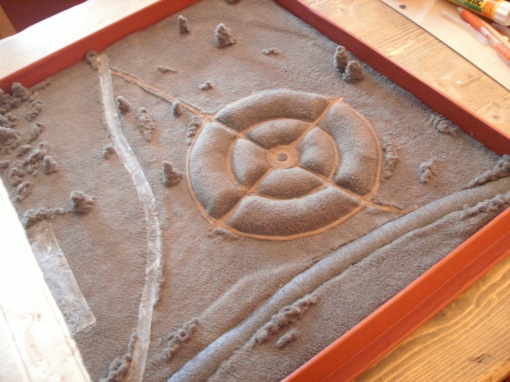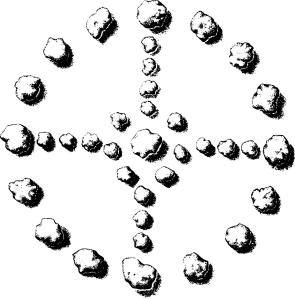I have been moved and humbled by the support and confidence so many have expressed in my proposal for the Town of Canmore’s 2010 Public Art Project. The goal this year was to produce a piece of environmental or land art to be placed at the site of the underpass being excavated under the Trans-Canada highway. I have promised a number of people that I would share the details of my proposal with you once the competition was over. Alas, the project commission has been granted to another artist, but there was enough in my proposal to give the committee pause and discussion. For myself, I felt an affinity for this project from the beginning and a vision began forming in my spirit’s eye. I was thrilled and excited to be short-listed for the project and set to. Many weeks of research and visualisation and writing and drawing and maquette-building followed. The result was a proposal for “The Wheel”, an earthwork maze in the shape of a wheel of the year. What follows is an excerpt from my proposal, which I hope you’ll enjoy/discuss.
The earthwork I proposed is formed of grassed berms and natural pathways, with a central stone platform. The full-scale installation would be approximately 25 metres in diameter, and about 1.5 metres high. The earthwork is bisected by earthen pathways formed in two concentric circles joined by four spoked paths – a quartered circle. The design of the circular earthwork maze installation is based on historically bonding symbolism.
For this project, it was essential to me to incorporate symbolism that embraces the history of all of our community, both the ancient history of our native peoples as well as the more recent settlement history. I wished to marry that with meaningful interaction with the community we are today, and reference to what we hope to be in the future.
I spent considerable time researching both the ancient and more recent history of this area: the culture of the Stoney Nakoda people, their symbolism and spirituality; the history of the original settlers to this area, most of whom originated from Scotland. In considering the Celtic history of that part of the world and the symbolism and spirituality carried to Canmore from the British Isles, I found a close correspondence between the values of both groups.
The common values and symbolism I found between the two cultures that historically made up our community refers to unity and oneness, a balanced and harmonious relationship of all of nature, including man in his place as part of that harmony. My research revealed a great deal about the use of the sacred hoop or ‘medicine wheel’ by the tribes of Alberta, in particular by the Assiniboine and Stoney Nakoda peoples (Figure 1). A ‘medicine wheel’ is an ancient stone circle formation used for many centuries for spiritual ceremonies by those peoples, some of which date back to a time before the pyramids of ancient Egypt were built. Some 66% of all known ‘medicine wheel’ formations are in Alberta. The wheels bear four or more ‘spokes’. There is detailed theology around the meaning of the ‘medicine wheel’ and its use as a tool for individual and group living of an aware and ecologically responsible life.
In researching the Celtic history, I found the Celts used the symbol of the Wheel of the Year (Figure 2), which I discovered employs identical symbolism and almost identical attributes to the ‘medicine wheel’ of the native peoples.
The Celtic wheel was later reinterpreted to incorporate the seasonal holidays (“holy days”) we have come to know from the Christian calendar (Figure 3).
These wheels symbolize the circle of life; unity; cyclical balance and harmony in all things; and the natural division of life’s cycles into four: the four ages of man; the four seasons; the four phases of the moon; the four directions; the four elements. The symbolism doesn’t depend on belief in any single belief system or God or deity, but depends more on our individual place and personal responsibility toward maintaining the balance and unity of our ecosystem.
This symbol spoke powerfully to me as a unifying symbol to reference our entire history, from the ancient right forward to the Canmore of today, and the value we place on our responsibility for, and harmony with, our natural environment and its other occupants. Both cultural belief systems identify the individual’s choices and actionsas being central to that cycle, and this is a concept I consider essential to all we seek to achieve for the sustainability of our community. For that reason, I placed a carved stone slab at the very centre of the maze, inviting – as I know it will – nearly every person who passes to occupy it, to stand on it however briefly and complete their place in this great cycle.
I hope with the maze-type installation to draw the feet, to slow the steps and slow the mind, to encourage people to be present in the moment, to see, to notice their environment, to forge a closer relationship with it. For those who traverse it regularly, I would hope those few daily seconds will nourish and nurture, however unconsciously, that relationship. Relationship leads to a sense of proprietorship, and is the antithesis of indifference. Yet it is important that the installation be relevant to our Canmore of today. For this reason, I wished to make it accessible, acceptable and expected for people to walk, to climb, to bike through or along, that children from the neighbouring homes and play area will clamber up its slopes in summer, and sled and slide down its slopes in winter. I hope that by encouraging feet and wheels and sleds, the members of my community would make this installation their own, would take a few extra seconds to follow their informal path through it, to embrace it and to love it.” – Dea Fischer, Town of Canmore proposal, 22 November 2010.





December 30, 2010 at 6:10 pm
fabulous model and proposal! our ideas are quite similar…thank-you for your support!
December 30, 2010 at 6:13 pm
Thanks Lucie, I’m gathering from your own post that they were quite similar indeed. Can’t wait to see. Great minds think alike? 😉
August 17, 2014 at 5:30 pm
From your treatise Dea I am moved to visit the site whether or not your proposal was the one chosen. I am not privy to the proposal chosen but it does sound like “Lucie” (the chosen one) was indeed exchanging vibrations with you.
Truly.